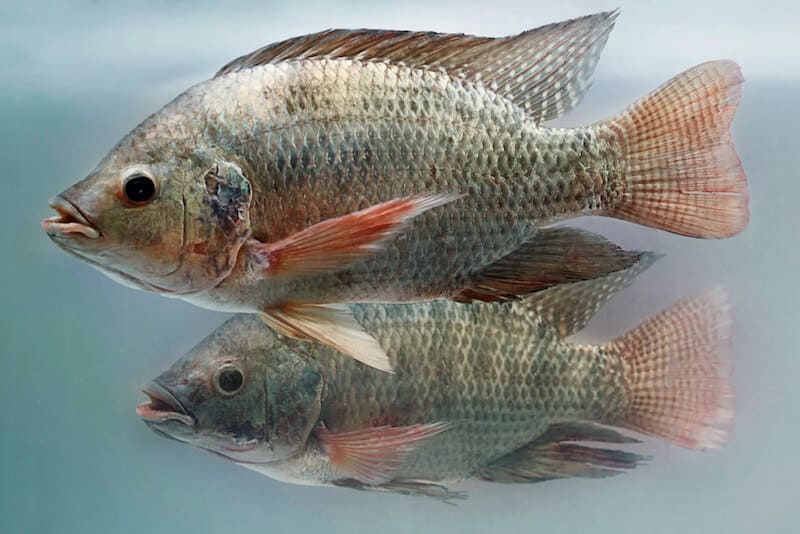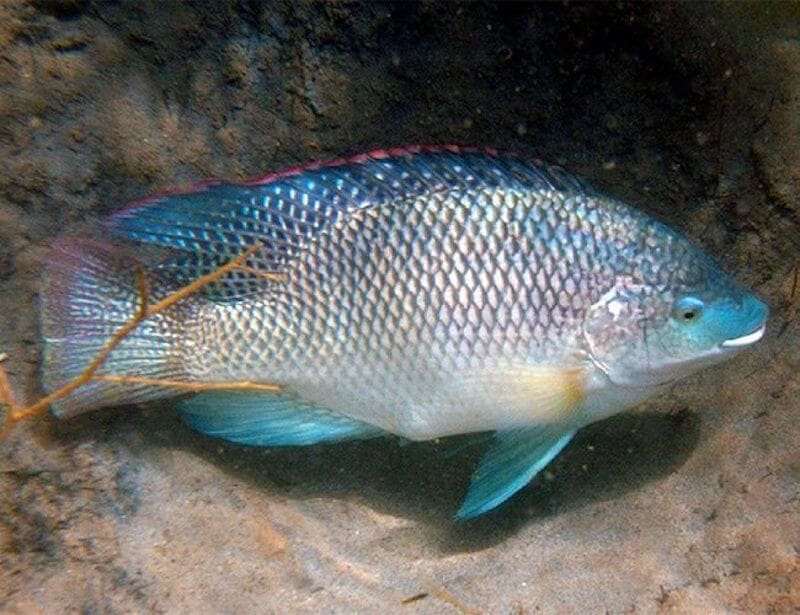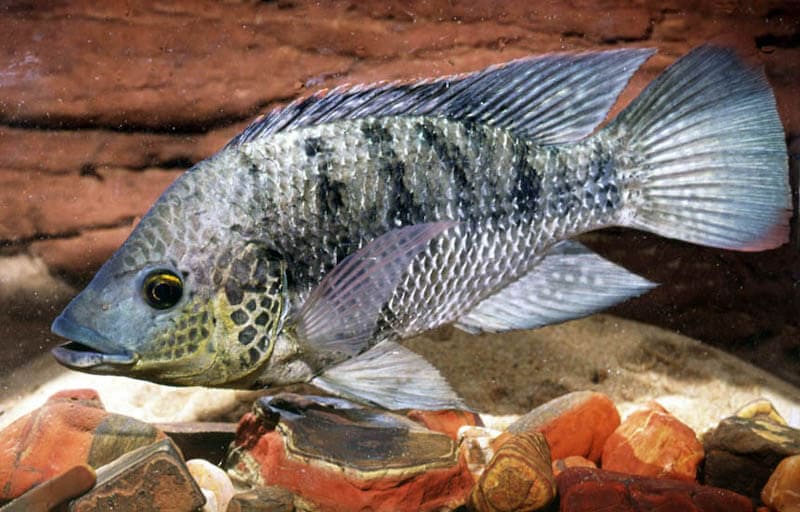
Tilapia is a freshwater fish that is popular in aquaculture and is widely consumed as a food source. The fish is native to Africa but has been introduced to many other parts of the world.
In its natural habitat, tilapia can be found in various freshwater environments, including rivers, lakes, and ponds. They prefer warm water temperatures and are known to thrive in water bodies with temperatures between 25°C and 32°C.
Tilapia became a domesticated fish asset for agriculture thousands of years ago in Ancient Egypt, where they were farmed in ponds and used for food. The fish is now one of the most widely farmed fish in the world, and it is commonly found in aquaculture operations in Asia, Africa, and Latin America.
In the wild, tilapia is known to feed on a variety of plant and animal matter, including algae, aquatic plants, and small invertebrates. They can grow up to 18 inches in length in the wild, but in captivity, they typically reach a maximum size of around 12 inches.
Tilapia is not considered an endangered fish in the wild but overfishing and habitat destruction have had an impact on some populations. They are also preyed upon by various aquatic predators such as larger fish, birds, and crocodiles.
Tilapia are known to school in the wild, and some species can migrate short distances to find suitable breeding and feeding grounds.
There are over 100 species of tilapia, but the most commonly farmed and consumed species are the Nile tilapia, blue tilapia, and Mozambique tilapia. These species have been selectively bred to improve their growth rates, disease resistance, and other desirable traits for aquaculture.
Nile tilapia (Oreochromis niloticus) is a freshwater fish species that belongs to the family Cichlidae. It is one of the most commonly farmed and consumed tilapia species in the world, especially in Asia, Africa, and the Middle East.

Nile Tilapia Appearance: Nile tilapia has a deep, laterally compressed body with an oval shape. It has a spiny dorsal fin and a soft rayed anal fin. The fish has a variable color pattern that can range from gray, green, and brown to yellow and blue, with a pink or white underbelly. Nile tilapia can grow up to 60 cm (24 inches) in length and weigh up to 4.5 kg (10 lbs) in the wild.
Fish Habitat and Distribution: Nile tilapia is native to Africa, specifically the Nile River basin, and it is also found in other freshwater systems across the continent. It has been introduced to many other parts of the world, including Asia, the Americas, and Europe, primarily for aquaculture purposes.
In the wild, Nile tilapia inhabit various freshwater habitats, such as rivers, lakes, ponds, and swamps, with warm water temperatures between 20°C and 34°C. They prefer shallow waters with a sandy or muddy bottom and some vegetation cover.
Tilapia Behavior and Diet: Nile tilapia is a social fish that forms schools and hierarchies. They are omnivorous and feed on a variety of plant and animal matter, such as algae, aquatic plants, small invertebrates, and detritus.
Fish Reproduction: Nile tilapia is a prolific breeder, and under favorable conditions, it can spawn multiple times a year. The males establish territories and build nests by excavating depressions in the sand or gravel bottom, where the females lay eggs that are then fertilized and guarded by the males until hatching.
Tilapia Aquaculture: Nile tilapia is one of the most commonly farmed fish species in the world, and it is particularly popular in aquaculture systems in Asia, Africa, and the Middle East due to its fast growth rate, adaptability, and resistance to diseases. It is raised in ponds, tanks, and cages using various feeding and management practices.
Blue tilapia (Oreochromis aureus) is a freshwater fish species that belongs to the family Cichlidae. It is a popular tilapia species for aquaculture and has been introduced to many parts of the world.

Blue Tilapia Appearance: Blue tilapia has a deep, laterally compressed body with an oval shape. It has a spiny dorsal fin and a soft rayed anal fin. The fish has a variable color pattern that can range from gray, green, and brown to blue and silver, with a pink or white underbelly. Blue tilapia can grow up to 45 cm (18 inches) in length and weigh up to 2.5 kg (5.5 lbs) in the wild.
Habitat and Distribution of blue tilapia: Blue tilapia is native to freshwater habitats in North and Central America, including rivers, lakes, and ponds. It has been introduced to other parts of the world for aquaculture purposes and can now be found in many freshwater systems in Africa, Asia, and the Middle East.
In the wild, blue tilapia inhabit warm freshwater habitats with temperatures between 20°C and 32°C. They prefer shallow waters with a sandy or muddy bottom and some vegetation cover.
Behavior and Diet: Blue tilapia is a social fish that forms schools and hierarchies. They are omnivorous and feed on a variety of plant and animal matter, such as algae, aquatic plants, small invertebrates, and detritus.
Reproduction, eggs and hatching: Blue tilapia is a prolific breeder, and under favorable conditions, it can spawn multiple times a year. The males establish territories and build nests by excavating depressions in the sand or gravel bottom, where the females lay eggs that are then fertilized and guarded by the males until hatching.
Blue tilapia is a freshwater fish species native to North and Central America that is popular for aquaculture and has been introduced to many parts of the world. It has an oval-shaped body, variable color pattern, and can grow up to 45 cm in length. Blue tilapia is an omnivorous social fish that prefers warm freshwater habitats with sandy or muddy bottoms and some vegetation cover. It is a prolific breeder that is commonly raised in aquaculture systems using various feeding and management practices.
Mozambique tilapia (Oreochromis mossambicus) is a freshwater fish species that belongs to the family Cichlidae. It is one of the most important tilapia species for aquaculture in many parts of the world, especially in Asia and Africa.

Afrcan Tilapia Appearance: Mozambique tilapia has a deep, laterally compressed body with an oval shape. It has a spiny dorsal fin and a soft rayed anal fin. The fish has a variable color pattern that can range from gray, green, and brown to yellow and silver, with a pink or white underbelly. Mozambique tilapia can grow up to 30 cm (12 inches) in length and weigh up to 1.5 kg (3.3 lbs) in the wild.
African Habitat and Distribution: Mozambique tilapia is native to freshwater habitats in Africa and Madagascar and has been introduced to other parts of the world for aquaculture purposes. It is commonly found in rivers, lakes, ponds, and swamps with warm water temperatures between 20°C and 35°C.
Mozambique Tilapia Behavior and Diet: Mozambique tilapia is a social fish that forms schools and hierarchies. They are omnivorous and feed on a variety of plant and animal matter, such as algae, aquatic plants, small invertebrates, and detritus.
African Fish Reproduction: Mozambique tilapia is a prolific breeder, and under favorable conditions, it can spawn multiple times a year. The males establish territories and build nests by excavating depressions in the sand or gravel bottom, where the females lay eggs that are then fertilized and guarded by the males until hatching.
African Aquaculture: Mozambique tilapia is a popular fish species for aquaculture, particularly in Asia and Africa. It is raised in ponds, tanks, and cages using various feeding and management practices. Mozambique tilapia is known for its fast growth rate, adaptability, and hardiness, making it a relatively easy fish to farm.
Ecological Impact: Mozambique tilapia has been introduced to many freshwater systems around the world, where it can have significant ecological impacts. In some cases, it can outcompete and displace native fish species, alter food webs, and modify aquatic habitats.
In summary, Mozambique tilapia is a freshwater fish species native to Africa that is important for aquaculture in many parts of the world. It has an oval-shaped body, variable color pattern, and can grow up to 30 cm in length. Mozambique tilapia is an omnivorous social fish that prefers warm freshwater habitats with sandy or muddy bottoms and some vegetation cover. It is a prolific breeder that is commonly raised in aquaculture systems using various feeding and management practices. However, it can have significant ecological impacts when introduced to non-native freshwater systems.